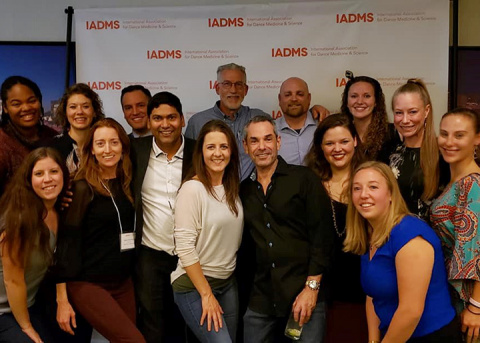
By the NATA Council on Practice Advancement Performing Arts Medicine Committee
Performing arts athletic trainers from across the United States attended the 29th annual Conference of the International Association for Dance Medicine & Science (IADMS) in Montreal, Quebec, Canada, in October 2019. The four-day conference brought together those involved with the health care, education, research, administration and supervision of dancers, including physicians, athletic trainers, physical therapists, alternative health care practitioners, psychologists, arts administrators, artistic directors, choreographers, educators, scientists, movement specialists and dancers.
Home to the Cirque du Soleil International Headquarters, attendees toured the Cirque production facility and watched the performance medicine team demonstrate an emergency extrication. Conference participants also enjoyed a performance by local Montreal professional dance company, RUBBERBANDance.
The 38 performing arts athletic trainers in attendance delivered 14 oral and 14 poster presentations on topics such as dance injury epidemiology in collegiate dancers, associations among selective functional movement assessment dysfunctions and injuries in university dancers, nutrition periodization in dancers, fatigue-related leap landing knee injuries in dancers and many more. Movement sessions were led by Alyssa McPherson MS, LAT, ATC, from Indiana University, on making foot intrinsic work functional and Kevin Brown MEd, ATC, from KORT Sports Medicine and the Louisville Ballet, on incorporating sensory integration techniques into rehabilitation. These sessions were filled with a variety of practitioners and dance educators and were great opportunities to showcase the rehabilitation skills of athletic trainers.
Research presented at the conference by Jeffrey A. Russell, PhD, ATC, FIADMS, about force attenuation properties of padded dance support socks was highlighted in the Dance Magazine article, “These 9 Dance Science Studies Could One Day Change Our Approach in the Studio.” The study examined the extent to which padded dance support socks (Apolla Shocks) could reduce force on the foot during a modern dance sequence and when landing from a sauté jump. Researchers found peak forces on the heel when dancing with padded dance socks were significantly lower compared with dancing barefoot (DS=35.2 N vs. BF=44.2 N; p=0.001). Initial findings of the study suggest that padded dance socks can attenuate peak force on the feet in dancers during a modern dance phrase, offering evidence to support the use of padded dance socks to protect dancers’ feet. More research is needed to determine the extent to which padded dance socks can decrease foot injury incidence and what force reduction quantity is clinically relevant for injury prevention.
Congratulations to all the presenters for a job well-done! Mark your calendars for the 30th annual IADMS Conference Oct. 22-25 in Chiba, Japan.





